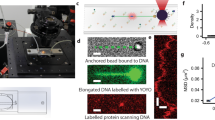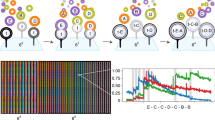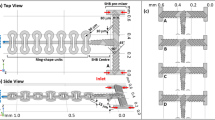Abstract
Handling and mixing ultrasmall volumes of reactants in parallel can increase the throughput1,2 and complexity3 of screening assays while simultaneously reducing reagent consumption1. Microfabricated silicon and plastic can provide reliable fluidic devices4,5,6,7,8, but cannot typically handle total volumes smaller than ∼1 × 10–12 l. Self-assembled soft matter nanocontainers9,10,11,12,13,14,15,16 can in principle significantly improve miniaturization and biocompatibility, but exploiting their full potential is a challenge due to their small dimensions17. Here, we show that small unilamellar lipid vesicles can be used to mix volumes as small as 1 × 10–19 l in a reproducible and highly parallelized fashion. The self-enclosed nanoreactors are functionalized with lipids of opposite charge to achieve reliable fusion. Single vesicles encapsulating one set of reactants are immobilized on a glass surface and then fused with diffusing vesicles of opposite charge that carry a complementary set of reactants. We find that ∼85% of the ∼1 × 106 cm–2 surface-tethered nanoreactors undergo non-deterministic fusion, which is leakage-free in all cases, and the system allows up to three to four consecutive mixing events per nanoreactor.
This is a preview of subscription content, access via your institution
Access options
Subscribe to this journal
Receive 12 print issues and online access
$259.00 per year
only $21.58 per issue
Buy this article
- Purchase on Springer Link
- Instant access to full article PDF
Prices may be subject to local taxes which are calculated during checkout



Similar content being viewed by others
References
Metzker, M. L. Sequencing technologies—the next generation. Nature Rev. Genet. 11, 31–46 (2010).
Dittrich, P. S. & Manz, A. Lab-on-a-chip: microfluidics in drug discovery. Nature Rev. Drug. Discov. 5, 210–218 (2006).
Sauer, S. et al. Miniaturization in functional genomics and proteomics. Nature Rev. Genet. 6, 465–476 (2005).
Whitesides, G. M. The origins and the future of microfluidics. Nature 442, 368–373 (2006).
Psaltis, D., Quake, S. R. & Yang, C. H. Developing optofluidic technology through the fusion of microfluidics and optics. Nature 442, 381–386 (2006).
Song, H., Chen, D. L. & Ismagilov, R. F. Reactions in droplets in microfluidic channels. Angew. Chem. Int. Ed. 45, 7336–7356 (2006).
Atencia, J. & Beebe, D. J. Controlled microfluidic interfaces. Nature 437, 648–655 (2005).
Walt, D. R. Fibre optic microarrays. Chem. Soc. Rev. 39, 38–50 (2010).
Chiu, D. T. et al. Chemical transformations in individual ultrasmall biomimetic containers. Science 283, 1892–1895 (1999).
Lizana, L. et al. Controlling chemistry by geometry in nanoscale systems. Annu. Rev. Phys. Chem. 60, 449–468 (2009).
Miller, O. J. et al. Directed evolution by in vitro compartmentalization. Nature Methods 3, 561–570 (2006).
van Dongen, S. F. M. et al. Biohybrid polymer capsules. Chem. Rev. 109, 6212–6274 (2009).
Bolinger, P. Y., Stamou, D. & Vogel, H. An integrated self-assembled nanofluidic system for controlled biological chemistries. Angew. Chem. Int. Ed. 47, 5544–5549 (2008).
Cisse, I., Okumus, B., Joo, C. & Ha, T. J. Fueling protein–DNA interactions inside porous nanocontainers. Proc. Natl Acad. Sci. USA 104, 12646–12650 (2007).
Vriezema, D. M. et al. Positional assembly of enzymes in polymersome nanoreactors for cascade reactions. Angew. Chem. Int. Ed. 46, 7378–7382 (2007).
Chiu, D. T. & Lorenz, R. M. Chemistry and biology in femtoliter and picoliter volume droplets. Acc. Chem. Res. 42, 649–658 (2009).
Christensen, S. M. & Stamou, D. Surface-based lipid vesicle reactor systems: fabrication and applications. Soft Matter 3, 828–836 (2007).
Boukobza, E., Sonnenfeld, A. & Haran, G. Immobilization in surface-tethered lipid vesicles as a new tool for single biomolecule spectroscopy. J. Phys. Chem. B 105, 12165–12170 (2001).
Stamou, D., Duschl, C., Delamarche, E. & Vogel, H. Self-assembled microarrays of attoliter molecular vessels. Angew. Chem. Int. Ed. 42, 5580–5583 (2003).
Lei, G. H. & MacDonald, R. C. Lipid bilayer vesicle fusion: intermediates captured by high-speed microfluorescence spectroscopy. Biophys. J. 85, 1585–1599 (2003).
Bendix, P. M., Pedersen, M. S. & Stamou, D. Quantification of nano-scale intermembrane contact areas by using fluorescence resonance energy transfer. Proc. Natl Acad. Sci. USA 106, 12341–12346 (2009).
Hatzakis, N. S. et al. How curved membranes recruit amphipathic helices and protein anchoring motifs. Nature Chem. Biol. 5, 835–841 (2009).
Lohse, B., Bolinger, P. Y. & Stamou, D. Encapsulation efficiency measured on single small unilamellar vesicles. J. Am. Chem. Soc. 130, 14372–14373 (2008).
Kunding, A. H., Mortensen, M. W., Christensen, S. M. & Stamou, D. A fluorescence-based technique to construct size distributions from single-object measurements: application to the extrusion of lipid vesicles. Biophys. J. 95, 1176–1188 (2008).
Yoon, T. Y. et al. Multiple intermediates in SNARE-induced membrane fusion. Proc. Natl Acad. Sci. USA 103, 19731–19736 (2006).
Christensen, S. M., Mortnesen, M. W. & Stamou, D. G. Single vesicle assaying of SNARE-synaptotagmin-driven fusion reveals fast and slow modes of both docking and fusion and intrasample heterogeneity. Biophys. J. 100, 957–967 (2011).
Haluska, C. K. et al. Time scales of membrane fusion revealed by direct imaging of vesicle fusion with high temporal resolution. Proc. Natl Acad. Sci. USA 103, 15841–15846 (2006).
Chan, Y. H. M., van Lengerich, B. & Boxer, S. G. Lipid-anchored DNA mediates vesicle fusion as observed by lipid and content mixing. Biointerphases 3, Fa17–Fa21 (2008).
Clark, M. A. et al. Design, synthesis and selection of DNA-encoded small-molecule libraries. Nature Chem. Biol. 5, 647–654 (2009).
Zhou, H. X., Rivas, G. N. & Minton, A. P. Macromolecular crowding and confinement: biochemical, biophysical, and potential physiological consequences. Annu. Rev. Biophys. 37, 375–397 (2008).
Acknowledgements
D.S. would like to acknowledge financial support from the Lundbeck Foundation Center for Biomembranes in Nanomedicine, the Danish Councils for Independent and Strategic Research and the University of Copenhagen programmes of excellence ‘UNIK Synthetic Biology’, ‘Single Molecule Nanoscience’ and ‘BioScaRT’.
Author information
Authors and Affiliations
Contributions
D.S. designed and supervised the project. S.M.C. and P-Y.B. conducted most experiments and data analysis and contributed equally to this work. S.M.C. and D.S. wrote the paper. All authors helped design experiments, discussed the results and commented on the manuscript.
Corresponding author
Ethics declarations
Competing interests
The authors declare no competing financial interests.
Supplementary information
Supplementary information
Supplementary information (PDF 766 kb)
Rights and permissions
About this article
Cite this article
Christensen, S., Bolinger, PY., Hatzakis, N. et al. Mixing subattolitre volumes in a quantitative and highly parallel manner with soft matter nanofluidics. Nature Nanotech 7, 51–55 (2012). https://doi.org/10.1038/nnano.2011.185
Received:
Accepted:
Published:
Issue Date:
DOI: https://doi.org/10.1038/nnano.2011.185
This article is cited by
-
Single-particle combinatorial multiplexed liposome fusion mediated by DNA
Nature Chemistry (2022)
-
A modular platform for one-step assembly of multi-component membrane systems by fusion of charged proteoliposomes
Nature Communications (2016)
-
Enzymatic reactions in confined environments
Nature Nanotechnology (2016)
-
Membranes on nanopores for multiplexed single-transporter analyses
Microchimica Acta (2016)
-
Lipid-nanostructure hybrids and their applications in nanobiotechnology
NPG Asia Materials (2013)



